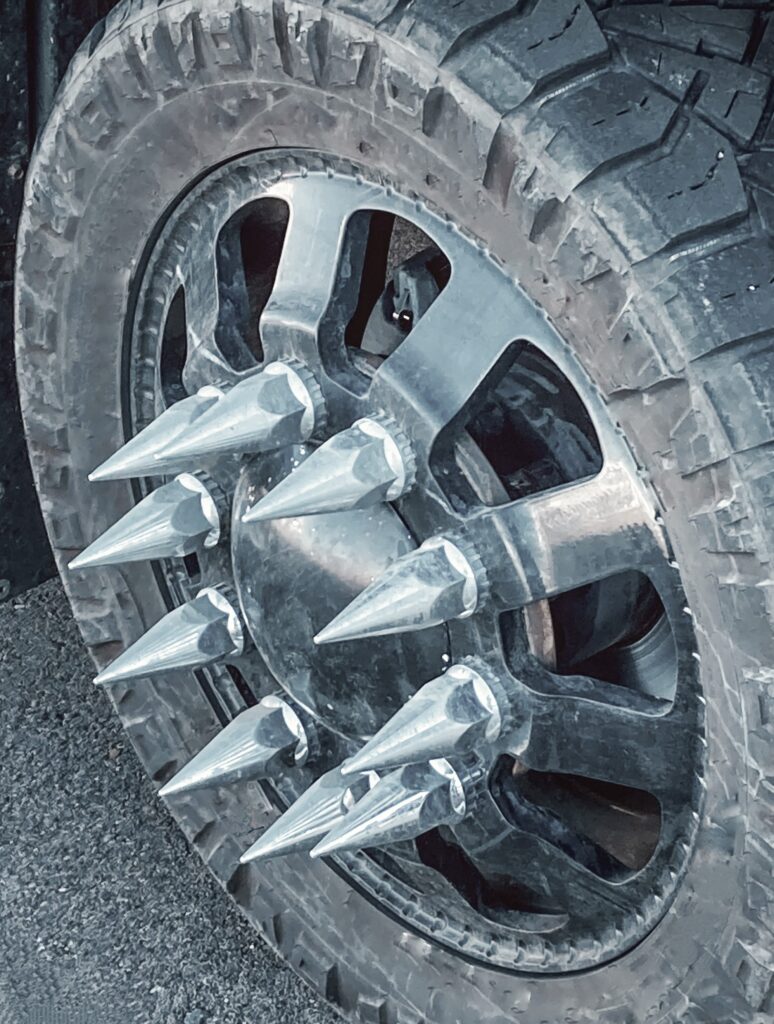
Author: John Mattiacci | Owner Mattiacci Law
Published March 22, 2025

Table of Contents
ToggleIf you’ve ever driven next to a semi-truck, you may have noticed large metal or plastic spikes protruding from the wheel hubs. This raises an important question: Why do semi trucks have spikes on their wheels?
Semi trucks have spikes on their wheels primarily for cosmetic appeal and to discourage cars from driving too closely. These spikes, usually made of plastic or aluminum, do not cause damage but create a visual deterrent. They also protect lug nuts from corrosion and debris.
If you’ve been injured in a crash involving a commercial truck, every detail—down to the equipment—can matter. Call Mattiacci Law at 215-914-6919 to speak with a proven truck accident injury attorney. With decades of experience handling complex trucking cases, we know how to investigate vehicle modifications and hold negligent parties accountable.
In this article, I’ll cover the purpose of wheel spikes, their legality, safety concerns, common misconceptions, and additional trucking modifications that impact safety.

What Are the Spikes on Semi Truck Wheels?
The spikes commonly seen on semi-truck wheels are lug nut covers designed to protect the wheel assembly. They are typically made of plastic, aluminum, or steel, and while they may appear sharp, most are hollow and lightweight.
What’s the Point of Spiked Hubcaps?
Spiked hubcaps are designed to protect lug nuts from rust and damage while also adding a decorative touch to a truck’s appearance.
Key functions include:
- Preventing Rust and Corrosion: Spikes act as covers to protect lug nuts from moisture and dirt.
- Reducing Maintenance Issues: Keeps lug nuts secure and extends the life of wheel fasteners.
- Aesthetic Appeal: Many truckers use spiked hubcaps to personalize their rigs.
While they may look aggressive, these spikes are not designed to be weapons or hazards—they serve a functional and decorative role.
Are Spikes on Truck Wheels Legal?
Yes, semi truck spikes are legal in most U.S. states, as long as they do not exceed width limits set by the Federal Motor Carrier Safety Administration (FMCSA).
Federal and state laws regulate the overall width of commercial vehicles, typically allowing up to 102 inches (8.5 feet) from side to side. Spikes that extend beyond this width may be considered illegal.
What States Have Laws Against Semi Truck Spikes?
| State | Are Spikes Legal? | Restrictions |
|---|---|---|
| California | ✅ Legal | Must not extend beyond the wheelbase. |
| New York | ✅ Legal | Must comply with width regulations. |
| Texas | ✅ Legal | No explicit restrictions. |
| Pennsylvania | ✅ Legal | Cannot exceed FMCSA width limits. |
| Florida | ✅ Legal | Must not create a road hazard. |
| Illinois | ❌ Potentially Illegal | Some counties restrict protruding spikes. |
| Other States | ✅ Legal | Subject to width and hazard laws. |
In most cases, semi truck spikes are legal unless they extend excessively beyond the wheel or pose a proven road hazard.
Are Semi Truck Wheel Spikes Dangerous?
Semi truck spikes are generally not dangerous, as they are made from plastic or lightweight metal and extend only a few inches from the wheel.
However, potential risks include:
- Damage to Pedestrians or Cyclists: If a truck comes too close to a cyclist or pedestrian, the spikes could cause injuries.
- Scraping in Close-Quarter Parking: When parking near curbs or in tight spaces, spikes can cause minor cosmetic damage to other vehicles.
Do Semi Truck Spikes Cause More Severe Accidents?
No, there is no evidence that semi truck spikes contribute to more severe accidents.
- In collisions, the impact force is absorbed by the truck’s frame, not the wheel spikes.
- Most spikes are made of plastic or aluminum, which would break upon impact.
- They do not significantly extend past the wheel, making them unlikely to puncture another vehicle’s tires.
While they may look intimidating, they do not increase the danger level of truck crashes in any measurable way.
Why Do Truckers Hit Their Tires with a Stick?
Truckers frequently hit their tires with a tire thumper, which is a small club or stick, to check for proper inflation.
Hitting tires with a stick allows truckers to quickly assess whether their tires are properly inflated without using a gauge.
The sound and feel of the impact help determine if:
- A tire is underinflated (it will sound dull and soft).
- A tire is properly inflated (it will have a solid “thud”).
- A tire is overinflated (it will have a sharp, high-pitched sound).
This method is a fast, effective way to check for potential tire blowouts before hitting the road.

Additional Truck Modifications That Impact Road Safety
Trucking companies and independent drivers often modify their vehicles for performance, safety, and efficiency.
Common Semi-Truck Modifications
| Modification | Purpose |
|---|---|
| Spiked Lug Nut Covers | Protects lug nuts from corrosion, adds decorative appeal. |
| Aerodynamic Side Skirts | Reduces drag and improves fuel efficiency. |
| Extended Bumpers (Moose Guards) | Protects the front of the truck from collisions with wildlife. |
| LED Underglow Lights | Increases nighttime visibility, though regulations vary by state. |
| Custom Exhaust Stacks | Enhances engine performance and reduces emissions in some cases. |
Misconceptions About Semi Truck Spikes
1. Do They Make Trucks More Dangerous?
No, they are typically made of lightweight materials like plastic or aluminum, which break on impact.
2. Are They Used as Weapons?
No, they are not designed for offensive or defensive use—they serve a functional and aesthetic purpose.
3. Do They Extend Beyond the Wheel?
Most spikes extend only a few inches, ensuring they remain within legal width limits.
4. Can They Cause Accidents?
There is no proven data linking truck wheel spikes to increased accidents or severity of crashes.
Contact Mattiacci Law for Truck Accident Representation
If you were involved in a truck accident and believe unsafe modifications or vehicle features played a role, you may be entitled to compensation. At Mattiacci Law, we fight aggressively to help accident victims recover compensation for medical expenses, lost wages, and pain and suffering.
Call us today at (215) 914-6919 to schedule a free no, obligation consultation. We don’t charge any fees unless we win your case.
Related Articles:
- How Much is the Average Truck Accident Settlement in Pennsylvania?
- What Are the Differences Between Truck and Car Accidents in Pennsylvania
Resources:
- Federal Motor Carrier Safety Administration (FMCSA)
- National Highway Traffic Safety Administration (NHTSA)
- Insurance Institute for Highway Safety (IIHS)
- Pennsylvania Department of Transportation (PennDOT)
